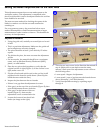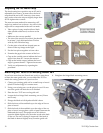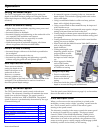
Single-Point Entry
Single point entry means that the sawblade
always enters the cut at the same location
regardless what the bevel angle is set to. The
pivot point of the bevel adjustment is
located at the bottom edge of the splinter
guard. This means that the cut will always
be along the splinter guard for any bevel
setting.
(Note that this is applicable only when the
guide rail is used. When the guide rail is not
under the saw, the bevel cut will move
slightly outward, away from the main body
of the saw.)
Setup and Adjustments
Setting up a New Saw
There are some simple setup procedures to follow before a
new saw can be used. Follow this sequence of inspections
and adjustments before using the saw for the first time. It is
important that these instructions be followed sequentially
before cutting the zero-clearance splinter guards.
Instruction Manual 7
!WARNING: Always disconnect the saw from the power
supply before making any adjustments to the saw or
installing or removing any accessory!
1. With the saw unplugged, inspect the blade for damage
and make sure it is properly secured to the arbor. (Refer
to "Changing the Sawblade" on page 10 for more
information).
!WARNING: Check regularly whether the saw blade is in
good condition. Saw blades which are cracked,
damaged, or deformed should no longer be used.
2. The riving knife is installed and adjusted at the factory,
however, you should verify that it is properly secured
and adjusted (refer to page 9 for more information).
!CAUTION: The riving knife is a safety feature of the saw to
prevent binding in the cut. All saw work should be
carried out only with the riving knife installed and
correctly set!
3. Install the power cord into the [Plug It] receptacle on the
saw (refer to page 14 for more information).
4. Perform the guide rail gib cam adjustment procedure
described on page 8.
5. After completing all of the inspections and adjustments
listed above, cut the zero-clearance splinter guards as
described on page 8.


















